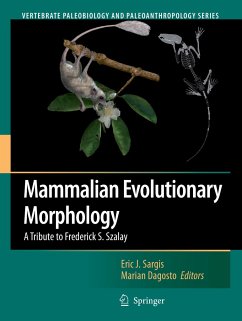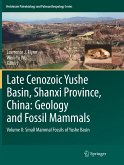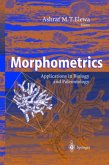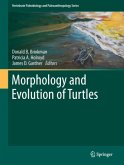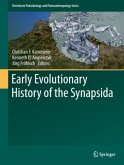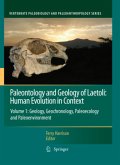This volume acknowledges and celebrates the contributions of Dr. Frederick S. Szalay to the field of Mammalian Evolutionary Morphology. Professor Szalay has published about 200 articles, four monographs, and six books on this subject. Throughout his career Professor Szalay has been a strong advocate for biologically and evolutionarily meaningful character analysis. In his view, this can be accomplished only through an integrated strategy of functional, adaptational, and historical analysis. Dr. Szalay worked on several different mammalian groups during his career, and the contributions to this volume reflect his broad perspective. Chapters focus on Primates, a group to which Professor Szalay dedicated much of his career. However, other mammalian groups on which he conducted a significant amount of research, such as marsupials and xenarthrans, are also covered in the volume.
This book will be of interest to professionals and graduate students in a wide variety of related fields, including functional morphology, systematics, vertebrate paleontology, mammalogy, primatology, biological anthropology, and evolutionary biology.
This book will be of interest to professionals and graduate students in a wide variety of related fields, including functional morphology, systematics, vertebrate paleontology, mammalogy, primatology, biological anthropology, and evolutionary biology.
From the reviews:
"This festschrift is a wonderful tribute to the legacy Szalay, it should certainly find a place on the bookshelf of every student of mammalian evolution". Erik R. Seiffert, Journal of Human Evolution 59; 704-709, 2010
"This volume will have a place on my bookshelf because the chapters are all solid contributions. Many of them could have been stand-alone papers in other venues. Dagosto and Sargis categorized the topics where Szalay made his biggest contributions, then sought out papers from researchers currently working on those topics. In this regard, the festschrift for Szalay has become a book that does more than celebrate his accomplishments; it compiles research that would certainly stimulate his interest. The volume is made stronger by its idiosyncrasies, arguably a reflection of the live and the career to whom it is dedicated. This makes this volume, in my mind, an exceptional tribute to the contribution of true giants in their respective fields. The impact of Szalay is undeniable. The impact and longevity of this volume will follow suit." Christopher P. Heesy, Department of Anatomy, Midwestern University, Evolutionary Anthropology 18: 157-158, 2009
"This volume ... is an extremely professional and well-produced book presenting up-to-date and cutting-edge research. ... The book is divided into two sections. ... Mammalian Evolutionary Morphology is a highly recommended advanced volume that will prove to be a relevant resource for professionals and postgraduate students in many evolutionary and palaeontological disciplines." Kris Kovarovic, PaleoAnthropology Society, 2009
"In their preface, editors Sargis and Dagosto provide a fascinating overview of Fred's life and career, as well as a systematic analysis of his contributions to our science. This topical organization provides a kind of scaffold for the entire volume, as the editors tell us how each of the individual chapters fits intoor contributes to these different themes. But the real accomplishment of the editors and the authors is that together, they have created a book that celebrates the scientific work of Fred Szalay by re-engaging with questions, issues, and problematic taxa that he himself worked on years or decades ago." R.L. Anemone, Journal of Mammalian Evolution, March 2010
"The book itself contains 18 chapters ... and spans the mammalian taxonomic and temporal spectrum from Early Cretaceous metatherians to extant primates. ... the book chapters are ... crisp, clear drawings, and photographic images. ... there is an enormous amount of new data within its pages that will be essential for professionals and students in those fields. ... this book stands as a great testament to both the man and his influential work." Gregg F. Gunnel, American Journal of Physical Anthropology, 2009
"This book is a fine tribute to the work of Frederick Szalay, whose many seminal contributions to the field of mammalian evolutionary morphology span a wide range of issues. ... Individual articles are well referenced and suitably illustrated with pertinent photographs, line drawings, tables, charts, and graphs. In addition to a general subject index, a taxonomic index is provided for ease in finding material on select taxa. Summing Up: Recommended. Upper-level graduate students, researchers, and professionals in evolutionary morphology, paleontology, and comparative anatomy." D. A. Brass, CHOICEce, Vol. 46 (4), December, 2008
"This volume ... is an extremely professional and well-produced book presenting up-to-date and cutting-edge research. ... The book is divided into two sections. ... Mammalian Evolutionary Morphology is a highly recommended advanced volume that will prove to be a relevant resource for professionals and postgraduate students in many evolutionary and palaeontological disciplines." Kris Kovarovic, PaleoAnthropology Society, 2009
"In their preface, editors Sargis and Dagosto provide a fascinating overview of Fred's life and career, as well as a systematic analysis of his contributions to our science. This topical organization provides a kind of scaffold for the entire volume, as the editors tell us how each of the individual chapters fits into or contributes to these different themes. But the real accomplishment of the editors and the authors is that together, they have created a book that celebrates the scientific work of Fred Szalay by re-engaging with questions, issues, and problematic taxa that he himself worked on years or decades ago." R.L. Anemone, Journal of Mammalian Evolution, March 2010
"The book itself contains 18 chapters ... and spans the mammalian taxonomic and temporal spectrum from Early Cretaceous metatherians to extant primates. ... the book chapters are ... crisp, clear drawings, and photographic images. ... there is an enormous amount of new data within its pages that will be essential for professionalsand students in those fields. ... this book stands as a great testament to both the man and his influential work." Gregg F. Gunnel, American Journal of Physical Anthropology, 2009
"This book is a fine tribute to the work of Frederick Szalay, whose many seminal contributions to the field of mammalian evolutionary morphology span a wide range of issues. ... Individual articles are well referenced and suitably illustrated with pertinent photographs, line drawings, tables, charts, and graphs. In addition to a general subject index, a taxonomic index is provided for ease in finding material on select taxa. Summing Up: Recommended. Upper-level graduate students, researchers, and professionals in evolutionary morphology, paleontology, and comparative anatomy." D. A. Brass, CHOICEce, Vol. 46 (4), December, 2008
"A detailed preface and bibliography provides an interesting review of Szalay's contributions to the field, and of his philosophical approaches to the subject. The many papers on early primates make this volume essential reading for students of this group. ... the work will also be of interest to those involved in the broader issues of mammalian functional morphology, descriptive anatomy, and phylogeny. It is an impressive volume, and a fitting tribute." (Darren Naish, Geological Magazine, Vol. 147 (5), 2010)
"This festschrift is a wonderful tribute to the legacy Szalay, it should certainly find a place on the bookshelf of every student of mammalian evolution". Erik R. Seiffert, Journal of Human Evolution 59; 704-709, 2010
"This volume will have a place on my bookshelf because the chapters are all solid contributions. Many of them could have been stand-alone papers in other venues. Dagosto and Sargis categorized the topics where Szalay made his biggest contributions, then sought out papers from researchers currently working on those topics. In this regard, the festschrift for Szalay has become a book that does more than celebrate his accomplishments; it compiles research that would certainly stimulate his interest. The volume is made stronger by its idiosyncrasies, arguably a reflection of the live and the career to whom it is dedicated. This makes this volume, in my mind, an exceptional tribute to the contribution of true giants in their respective fields. The impact of Szalay is undeniable. The impact and longevity of this volume will follow suit." Christopher P. Heesy, Department of Anatomy, Midwestern University, Evolutionary Anthropology 18: 157-158, 2009
"This volume ... is an extremely professional and well-produced book presenting up-to-date and cutting-edge research. ... The book is divided into two sections. ... Mammalian Evolutionary Morphology is a highly recommended advanced volume that will prove to be a relevant resource for professionals and postgraduate students in many evolutionary and palaeontological disciplines." Kris Kovarovic, PaleoAnthropology Society, 2009
"In their preface, editors Sargis and Dagosto provide a fascinating overview of Fred's life and career, as well as a systematic analysis of his contributions to our science. This topical organization provides a kind of scaffold for the entire volume, as the editors tell us how each of the individual chapters fits intoor contributes to these different themes. But the real accomplishment of the editors and the authors is that together, they have created a book that celebrates the scientific work of Fred Szalay by re-engaging with questions, issues, and problematic taxa that he himself worked on years or decades ago." R.L. Anemone, Journal of Mammalian Evolution, March 2010
"The book itself contains 18 chapters ... and spans the mammalian taxonomic and temporal spectrum from Early Cretaceous metatherians to extant primates. ... the book chapters are ... crisp, clear drawings, and photographic images. ... there is an enormous amount of new data within its pages that will be essential for professionals and students in those fields. ... this book stands as a great testament to both the man and his influential work." Gregg F. Gunnel, American Journal of Physical Anthropology, 2009
"This book is a fine tribute to the work of Frederick Szalay, whose many seminal contributions to the field of mammalian evolutionary morphology span a wide range of issues. ... Individual articles are well referenced and suitably illustrated with pertinent photographs, line drawings, tables, charts, and graphs. In addition to a general subject index, a taxonomic index is provided for ease in finding material on select taxa. Summing Up: Recommended. Upper-level graduate students, researchers, and professionals in evolutionary morphology, paleontology, and comparative anatomy." D. A. Brass, CHOICEce, Vol. 46 (4), December, 2008
"This volume ... is an extremely professional and well-produced book presenting up-to-date and cutting-edge research. ... The book is divided into two sections. ... Mammalian Evolutionary Morphology is a highly recommended advanced volume that will prove to be a relevant resource for professionals and postgraduate students in many evolutionary and palaeontological disciplines." Kris Kovarovic, PaleoAnthropology Society, 2009
"In their preface, editors Sargis and Dagosto provide a fascinating overview of Fred's life and career, as well as a systematic analysis of his contributions to our science. This topical organization provides a kind of scaffold for the entire volume, as the editors tell us how each of the individual chapters fits into or contributes to these different themes. But the real accomplishment of the editors and the authors is that together, they have created a book that celebrates the scientific work of Fred Szalay by re-engaging with questions, issues, and problematic taxa that he himself worked on years or decades ago." R.L. Anemone, Journal of Mammalian Evolution, March 2010
"The book itself contains 18 chapters ... and spans the mammalian taxonomic and temporal spectrum from Early Cretaceous metatherians to extant primates. ... the book chapters are ... crisp, clear drawings, and photographic images. ... there is an enormous amount of new data within its pages that will be essential for professionalsand students in those fields. ... this book stands as a great testament to both the man and his influential work." Gregg F. Gunnel, American Journal of Physical Anthropology, 2009
"This book is a fine tribute to the work of Frederick Szalay, whose many seminal contributions to the field of mammalian evolutionary morphology span a wide range of issues. ... Individual articles are well referenced and suitably illustrated with pertinent photographs, line drawings, tables, charts, and graphs. In addition to a general subject index, a taxonomic index is provided for ease in finding material on select taxa. Summing Up: Recommended. Upper-level graduate students, researchers, and professionals in evolutionary morphology, paleontology, and comparative anatomy." D. A. Brass, CHOICEce, Vol. 46 (4), December, 2008
"A detailed preface and bibliography provides an interesting review of Szalay's contributions to the field, and of his philosophical approaches to the subject. The many papers on early primates make this volume essential reading for students of this group. ... the work will also be of interest to those involved in the broader issues of mammalian functional morphology, descriptive anatomy, and phylogeny. It is an impressive volume, and a fitting tribute." (Darren Naish, Geological Magazine, Vol. 147 (5), 2010)

